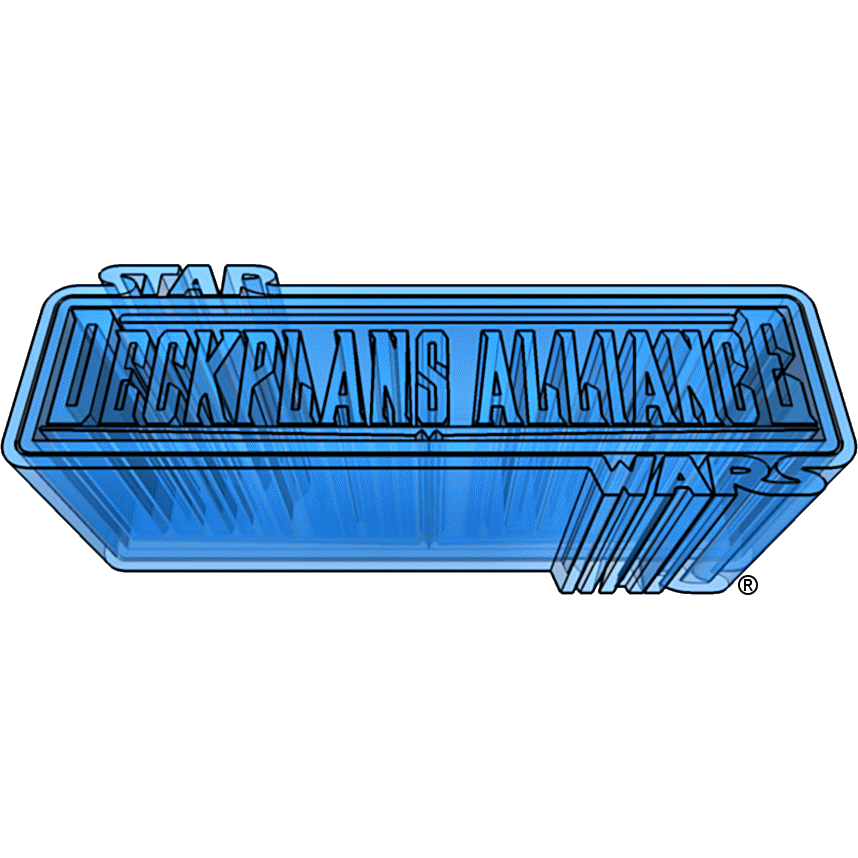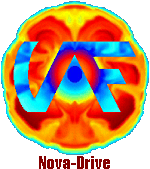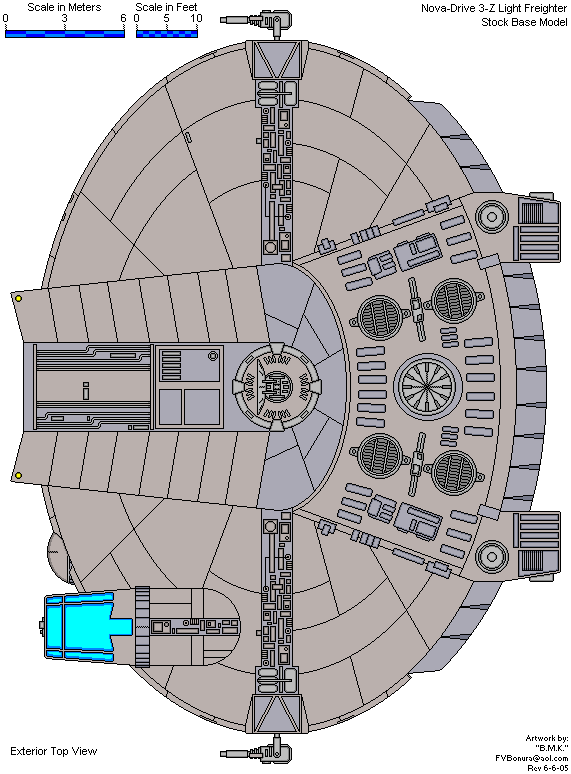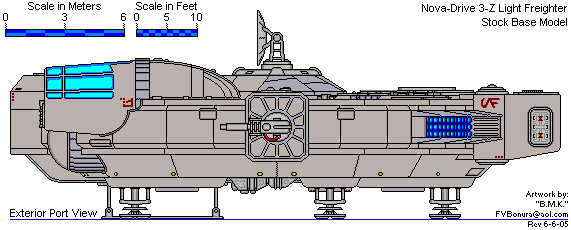


Nova-Drive 3-Z Light Freighter
|
Behind the Scenes: This joint-effort project was developed by "B.M.K.", and Frank Bonura. The 3-Z freighter is based on the original artwork from page 46 of "The STAR WARS Planets Collection" drawn by John Paul Lona, and was also inspired by exterior artwork from page 33 of "STAR WARS -- Stock Ships" drawn by Christina Wald. The official capsule from "Stock Ships" had many errors and inconsistencies that we discovered while developing the exterior and deckplan of this ship. We tried to use as much of the "Stock Ships" information as possible, but you will soon see we departed radically in many areas for reasons of common sense and practicality. "Stock Ships" alleges the 3-Z is a sub-licensed YT-1200 design, but in developing the deckplan, we realized it is a truly unique creation of Nova-Drive. Comparing the lengths of a YT-1210, and the 3-Z it is more likely the ship was shortened not widened to give it an oval shape. Shortening a ship also reduces production costs. By stretching or shortening the hull, the entire ship was changed structurally, as the hull became an oval. Much of the original ship was gone with this one alteration. "Stock Ships" alleges the 3-Z has an excellent scanning radius. The central-dorsal mounted sensor dish provides average sensor performance compared to other space transports (see stats). This suggests an inexpensive system was used, and mounted in this manner to boost range, and provide similar performance compared with more expensive internally mounted systems. |
The laser cannon description (firing arcs) in the "Stock Ships" capsule does not agree with its own stats. I believe the stats are correct because they match other 3-Z sources like "The STAR WARS Planets Collection". The port side cannon can fire in the forward, left, and rear fire arcs, but not to the right. I do not think the ship can fire upon targets above or below it with the stock cannons. The stock cannons can pivot, but can not rotate. "Stock Ships" alleges the 3-Z has superior cockpit visibility. As far as our research could reveal, both the YT-1300 and the 3-Z are about the same. "Stock Ships" alleges R&D costs were not included in the ship's price tag. Considering the degree of change this ship's design underwent, having started as a YT-1200, we had to conclude the R&D costs were included in the price of the ship and that the engineers were forced to cut costs elsewhere to produce a ship of this price range with these specs. NOTE: The theories put forth in this section reflect the changes in story elements and deckplan design we needed to make this ship work, and to correct the errors of "Stock Ships". We have included the original stats and capsule on this page (see below) as they appeared in "Stock Ships" (errors and all) so that players and GMs can come to their own conclusions. |

|
Starting with the top view of the 3-Z from page 46 of "The STAR WARS Planets Collection", we developed the top view that formed the foundation of the project. The callouts on page 46 identify the two aft projections as "Sublight Drives". Page 46 also calls the long curved flaps that cover the aft perimeter of the ship the "Hyperdrive". Confused by these callouts, we then studied the footage of the Millennium Falcon in the STAR WARS movies (ANH, TESB, ROTJ), |
and studied the research work of Mr. Robert Brown (Millennium Falcon Expert). Assuming both ships (YT-1300, and 3-Z) use similar looking and functioning propulsion, we concluded the callouts were in error. We finally decided to switch the functions of the two structures in their 3-Z design. The aft projections of the 3-Z now serve as the ship's hyperdrives, and the curved flaps now provide sublight thrust for the ship. |


|
Nova-Drive 3-Z Craft: Nova-Drive 3-Z Type: Light freighter Scale: Starfighter Length: 28 meters Skill: Space transports Crew: 2 Passengers: 8 Cargo Capacity: 150 metric tons Consumables: 2 months Cost: 60,000 credits (new), 20,000 credits (used) Hyperdrive Multiplier: x2 Hyperdrive Backup: x15 Nav Computer: Yes Maneuverability: 1D Space: 4 Atmosphere: 280; 800 kmh Hull: 4D+2 Shields: 1D Sensors: Passive. 20/OD Scan: 30/1D Search: 40/1D+2 Focus: 2/2D Weapons: Two Laser Cannons Fire Arc: Front, right, back Crew: 1(co-pilot) Skill: Starship gunnery Fire Control: 1D Space Range: 1-3/12/25 Atmosphere Range: 100-300/1.2/2.5 kmh Damage: 3D |
Capsule: Nova-Drive is a small Mid-Rim ship manufacturer that sells most of its small range of freighters in systems along the Rimma Trade Route. It does not design its own models, instead licensing or purchasing designs from other firms and manufacturing modified versions for niche markets. Nova-Drive sub-licensed the manufacturing plans of Corellian Engineering Corporation's YT-1200 a few months after the latter company phased it out in favor of later production models. Though CEC deemed the line too dated for active production, Nova-Drive saw an opportunity to upgrade the design to make it competitive with current offerings in the independent spacer market. The hull was stretched and reinforced, allowing for more powerful engines, larger cargo bays, and more spacious living quarters. The 3-Z is as fast at sublight speeds as a stock YT-1300, and features some moderate improvements over the YT-1300--the central-dorsal mounted sensor dish provides an excellent scanning radius; the standard port-starboard mounted laser cannons provides excellent forward-above-below-rear firing arcs; and the forward-opening cargo bay allows easy access to the cargo bays. Additionally, the cockpit featured a more open cockpit canopy than the YT-1300, and the primary escape pod is in the primary crew area. Because Nova-Drive did not have to include R&D costs in the price tag, the Nova-Drive 3-Z is priced very competitively. CEC has been surprised to discover that its cast-off design, revamped and upgraded, is giving its current YT offerings a run for their money. |

|
Central Compartments: Lift Room: Primary access into the ship is made via the main lift in the center of the bow. This lift has been designed with pivots on the pistons to allow the front end to be lowered independently of the rear end, thus allowing it to be used as a ramp for quick entry, exit, or lowered completely to function as a cargo lift. Forward Airlock: Located forward of the lift room, this area is suitable for space walks and ship-to-ship docking. Outside the airlock is the docking equipment and couplers. Central Cargo Hold: Located aft of the lift room, this area is the primary staging area for cargo being transferred into and out of the ship. This hold contains gratings for servicing access. There are two large doors to either side of this hold for cargo movement to the port and starboard holds respectively, the center of the front wall has double-pocket doors leading to the main/lift room, to either side of this door are two small doors which lead into the crew areas, and at the center of the aft wall is the door leading into the engine room. The central hold has full wall padding and a designated NO LOAD area that allows for emergency travel through the hold. Crew Areas: These areas are separated into a starboard and port sections by the lift room and airlock. See starboard and port compartments below for more information. Engine Room: Located aft of the central hold, this is the largest compartment on the ship. This room is accessed from one door in the central hold and two doors in the starboard and port holds respectively. At the center of this room sits the power core. In front of the core is a control panel and a series of access grates. It is flanked on either side by the four ion drive and thruster assemblies. The central thruster assemblies provide forward thrust through the primary filaments, while two outer thruster assemblies snake around to either side to feed into the port and starboard filaments; providing additional thrust as well as enhanced maneuvering. Mounted atop the side ion drives are the shield generators and controllers. In the forward corners of the engine room are a series of small fuel tanks and fuel management systems. The far forward corners are filled up with wire trunks. In the far port and starboard corners of the engine room are contoured fuel tanks. Trailing behind the engine room, in the hyperdrive compartments, are the primary and back-up hyperdrives, as well as their related management/control equipment. These compartments can be accessed from outside the ship by way of a hatch in the side of the compartment. There is enough room just inside this hatch for an average sized person or an astromech droid to fit with the hatch closed. Set into the external side walls of the hyperdrive compartments are a series of heat shields. GAME NOTES: This ship is equipped with a decentralized hyperdrive system. If both units are in working order, the ship has a hyperdrive rating of X2. If only one of these units is working, the ship functions at its backup speed of X15. |
Starboard Compartments: Starboard Crew Areas: Entered from the central hold through the common room. Common Room: This area serves as the primary socialization and recreation area, as well as the ship's galley (kitchen). It contains: a long table with seating for ten, a food processor, pantry, and sink. Starboard Hallway: Located forward of the common room is a hallway leading to the starboard crew quarters and the access to the ship's life support equipment and consumables. Crew Quarters: Each of the crew quarters has a padded, fully integrated double bunk, and two closets. This is mirrored on the port side as well. Starboard Hold: This area is accessed from the central hold by way of a large cargo access door. This hold has wall padding on most surfaces. In the center of the hold are gratings for service access. Amidst this grating is the starboard hyperdrive pit. Along the wall are two doors leading into the engine room. On the far outer wall are two large access panels into the starboard gun/equipment compartment. Immediately below these access panels are two grates over the compartment's main power junction from the core. Life Support room: Located at the front end of the hold, the compartment houses life support equipment and consumables. This compartment is accessed by way of a hallway in the starboard crew area. Adjacent to the life support room is the starboard hyperdrive fluid tank. Port Compartments: Port Crew Areas: Entered from the central hold through the port hallway. Immediately on your right as you enter the port crew area is a door leading into the restroom. Port Hallway: Located forward of the central hold, this long hallway connecting the port crew quarters, the head (bathroom), escape pod access, and door into the port hold. Head (Bathroom): This area features three toilets, three sinks, and a shower for two. Escape Pod Access: This passage is an airlock between the port hallway of the port crew area and the escape pod tube. Port Hold: Most of the areas in the port hold are directly mirrored from the starboard hold, save the following differences. At the front of the port hold is a designated NO LOAD area which serves as the cockpit escape route to the escape pod. It runs from the base of the cockpit access stairs to a door into the port hallway of the crew area. Just forward of this is the escape pod. To the left of the escape pod is an access panel leading under the cockpit, this area is largely empty except for some of primary control and management connections to the cockpit, and otherwise it is a perfect area for expansion and upgrades. Escape Pod Tube: Mounted in this area is a standard Nova-Drive Z-series 10-seat lifeboat, in its launch tube. The escape pod is accessed through the port hallway of the crew area. When ejected, the cover over the escape pod breaks away (via explosive charges) from the ship allowing the pod to exit. Adjacent to the escape pod tube is the port hyperdrive fluid tank. Cockpit: Accessed by way of a curving set of stairs. Once inside the cockpit, there are equipment bays to either side. There are two grates in the floor over the primary connections from the cockpit to the rest of the ship. The cockpit seats four, the pilot, co-pilot, and two others. The cockpit has an Corellian YT transport style full wrap-around console featuring multiple displays and monitors. Some of the sensor management systems are placed in the nose of the cockpit. Avionics systems (starboard), and circuit breakers (port), are located in rooms behind the cockpit. |